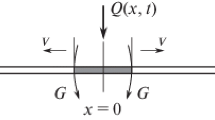We consider the inverse problem of thermoelasticity for a long inhomogeneous rectangular beam under the conditions of constant axial strains in the presence of a stationary temperature field and convective heat exchange with ambient media. The elastic and thermal characteristics of the beam material in its cross section are arbitrary functions of coordinates. We establish the formulas for the temperature distributions on the lateral surfaces of the beam, heat-transfer coefficients, and densities of the internal heat sources guaranteeing the absence of thermal stresses in the beam. We also deduce analytic dependences of the thermal conductivity and the coefficients of linear thermal expansion on the coordinates corresponding to the absence of stresses in the beam without internal heat sources.
Similar content being viewed by others
References
Yu. A. Amenzade, Elasticity Theory [in Russian], Vysshaya Shkola, Moscow (1976); https://www.bookdepository.com/Theory-Elasticity-Yu-Amenzade/9780714713281.
B. M. Kalynyak, “Guaranteeing the absence of radial stresses in a long hollow cylinder by the inhomogeneity of material,” Fiz.- Khim. Mekh. Mater., 52, No. 2, 104–110 (2016); English translation: Mater. Sci., 52, No. 2, 261–268 (2016); https://doi.org/https://doi.org/10.1007/s11003-016-9953-x.
B. M. Kalynyak, “Attainment of zero radial stresses in inhomogeneous long hollow cylinders by stationary temperature fields,” Fiz.- Khim. Mekh. Mater., 52, No. 1, 91–97 (2016); English translation: Mater. Sci., 52, No. 1, 99–107 (2016); https://doi.org/https://doi.org/10.1007/s11003-016-9931-3.
R. M. Kushnir, V. S. Popovych, and A. V. Yasins’kyi, Optimization and Identification in the Thermomechanics of Inhomogeneous Bodies, in: Ya. Yo. Burak and R. M. Kushnir (editors), Modeling and Optimization in the Thermomechanics of Conducting Inhomogeneous Bodies [in Ukrainian], Vol. 5, Spolom, Lviv (2011).
E. Melan and H. Parkus, Wärmespannungen Infolge Stationärer Temperaturfelder, Springer, Wien (1953).
Ya. S. Pidstryhach, Selected Works [in Ukrainian], Naukova Dumka, Kyiv (1995).
V. Birman and L. W. Byrd, “Modeling and analysis of functionally graded materials and structures,” Appl. Mech. Rev., 60, No. 5, 195–216 (2007); https://doi.org/https://doi.org/10.1115/1.2777164.
S. Ding and C.-P. Wu, “Optimization of material composition to minimize the thermal stresses induced in FGM plates with temperature-dependent material properties,” Int. J. Mech. Mater. Des., 14, No. 4, 527–549 (2018); https://doi.org/https://doi.org/10.1007/s10999-017-9388-z.
M. Kutz (editor), Handbook of Environmental Degradation of Materials, William Andrew, Norwich (2005).
R. M. Mahamood and E. T. Akinlabi, Functionally Graded Materials, Springer, Cham (2017).
M. Nemat-Alla, “Reduction of thermal stresses by composition optimization of two-dimensional functionally graded materials,” Acta Mech., 208, Nos. 3-4, 147–161 (2009); https://doi.org/https://doi.org/10.1007/s00707-008-0136-1.
M. Naebe and K. Shirvanimoghaddam, “Functionally graded materials: A review of fabrication and properties,” Appl. Mater. Today, 5, 223–245 (2016); https://doi.org/https://doi.org/10.1016/j.apmt.2016.10.001.
Y. Ootao, R. Kawamura, Y. Tanigawa, and R. Imamura, “Optimization of material composition of nonhomogeneous hollow circular cylinder for thermal stress relaxation making use of neural network,” J. Therm. Stresses, 22, No. 1, 1–22 (1999); https://doi.org/https://doi.org/10.1080/014957399281020.
J. N. Reddy and C. D. Chin, “Thermomechanical analysis of functionally graded cylinders and plates,” J. Therm. Stresses, 21, No. 6, 593–626 (1998); https://doi.org/https://doi.org/10.1080/01495739808956165.
A. Saiyathibrahim, S. S. M. Nazirudeen, and P. Dhanapal, “Processing techniques of functionally graded materials—a review,” in: Proc. of the Int. Conf. on Systems, Science, Control, Communication, Engineering, and Technology, ICSSCCET-2015, edited by T. Ramachandran, K. Kokula Krishna Hari, B. Thiruvengadam, and J. Daniel, Vol. 1, pp. 98–105.
M. U. Uysal, “Investigation of thermal and mechanical loading on functional graded material plates,” Int. J. Aerospace Mech. Eng., 7, No. 11, 2283–2289 (2013); https://doi.org/https://doi.org/10.5281/zenodo.1089161.
R. C. Wetherhold, S. Seelman, and J. Wang, “The use of functionally graded materials to eliminate or control thermal deformation,” Compos. Sci. Technol., 56, No. 9, 1099–1104 (1996); https://doi.org/https://doi.org/10.1016/0266-3538(96)00075-9.
A. Yasinskyy, “Determination and optimization of stress state of bodies on the basis of inverse thermoelasticity problems,” in: R. B. Hetnarski (editor), Encyclopedia of Thermal Stresses, Springer, Dordrecht (2014), Vol. 2, pp. 916–924; https://doi.org/https://doi.org/10.1007/978-94-007-2739-7_607.
Author information
Authors and Affiliations
Corresponding author
Additional information
Translated from Matematychni Metody ta Fizyko-Mekhanichni Polya, Vol. 62, No. 4, pp. 172–179, October–December, 2019.
Rights and permissions
Springer Nature or its licensor holds exclusive rights to this article under a publishing agreement with the author(s) or other rightsholder(s); author self-archiving of the accepted manuscript version of this article is solely governed by the terms of such publishing agreement and applicable law.
About this article
Cite this article
Kalynyak, B.M. Stationary Temperature Field Ensuring the Absence of Thermal Stresses in an Inhomogeneous Rectangular Beam. J Math Sci 265, 551–560 (2022). https://doi.org/10.1007/s10958-022-06070-w
Received:
Published:
Issue Date:
DOI: https://doi.org/10.1007/s10958-022-06070-w



